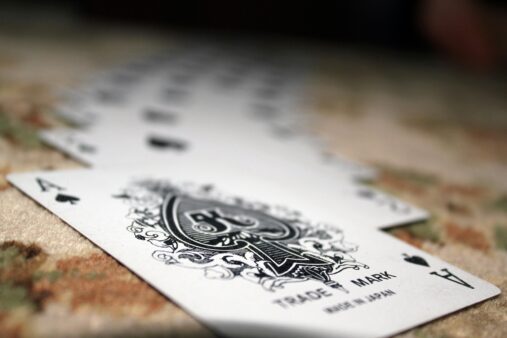Gambling has always been an exciting phenomenon in human culture and directly reflects human social values and psychology. It started with dusty dices of ancient Mesopotamia to today’s digital platforms, gambling has emerged as an intricate blend of tradition and innovation. Humans have always been fascinated by risk – have the gods forsaken me – and reward – are my lucky stars shining down on me? It has always been a reflection of the human spirit, which is driven by risk, reward, and the thrill of the unknown. Let’s trace the interesting journey of gambling: is it truly what you sow, you reap? Or is there something more intricate at play -the start aligning – which has kept the human mind fascinated for so long?
Via Pexels
Gambling Among The Ancient Civilizations
History and the Emergence of Gambling
Gambling originates from prehistoric societies, where inhabitants played various games of chance using stones, sticks, or animal bones.
The earliest known dice were made from knucklebones, which have been found in archaeological digs and date as far back as 3000 BCE in Mesopotamia. Such games served as one of the primary avenues for socialization and the amicable resolution of conflict. Anthropologists believe this constituted a sharing of experiences that could bring a community together.
Gambling in Religious Functions
It finds its association with religious rituals in many ancient cultures. In Ancient Greece and Rome, their citizens hatched on the belief that the casting of lots or dice rolling showed the will of gods. These lotteries were not spiritual but entertained an increasing public. Usually, the interpretation was read out by priests and shamans and used as a guide for important decisions touching on warfare, governance, and administration of justice. This divine connection gave gambling a form of legitimacy and purpose, elevating its place in society.
Gambling in the Roman Empire
The Romans loved to gamble on games such as “tabula,” an ancient version of backgammon. For Romans, gambling had become a part of life, and it was participated in by both emperors and ordinary citizens. Thanks to the growth in losses, laws were gradually established with the view to restrict its excesses. Despite these regulations, gambling continued underground undeterred, a fact that attests to its great appeal. Archaeological evidence of gambling boards and dice further underlines its prevalence throughout all levels of Roman society.
China and the Birth of Playing Cards
The influence of China on gambling is immense. By 2300 BCE, the Chinese were already playing lottery-style games. These card games were invented later during the Tang Dynasty, which was between 618 and 907 CE. They later traveled along the trade routes to reach Europe. These cards were beautifully illustrated, reflecting the art of their times. The integration of Chinese culture and gambling shows how it belongs both to recreation and strategy, and it is also a theme that continues today.
India’s Gambling Legacy
Gambling figures in historical texts, such as in the places of Mahabharata, where dice games were a pivotal point. These stories depict the cultural importance of a bet for amusement and moral teachings. The sharp presentation of gambling outcomes in Indian mythology stands for all times as a reminder of how fine a line skill and chance are and of moral lessons on too much indulgence.
The Middle Ages and the Renascence
Spread of Gambling in Medieval Europe
In spite of the most severe prohibitions of the Church, gambling prospered in the Middle Ages. The games of “hazard,” which is considered to be the ancestor of the contemporary game of craps, enjoyed a high level of popularity among soldiers and merchants. Most games of chance moved down trade routes, meaning they easily could have traversed entire regions and permeated various cultures. The secretive nature of gambling in that era added to its appeal and made it one of the most widespread clandestine activities.
Playing Cards’ Appearance in Europe
By the 14th century, playing cards found their way into Europe, most probably through the Islamic world, with whom trade was common. Until the time of printing, cards were hand-made and very expensive; thereafter, printing made them far more accessible. This symbolic imagery on such cards often described levels of society or values held by that society and usually reflected the culture and times. Since they were portable, such cards gained mass appeal and proved to be staples of European amusement.
Gambling Houses in Renaissance Italy
The rich in Renaissance Italy had created “ridotti,” or houses of gambling in which the players could gamble in style. Most would consider this the establishment of Venice’s Ridotto in 1638, the first regulated casino. Gambling houses served purposes other than gambling; social and political meetings were also held at these establishments to further display Renaissance sophistication and extravagance.
The Impact of Monarchies
Gambling also gained widespread legitimation from European monarchies. Lotteries were run in order to finance state projects, thus mixing gambling with public administration. Royalty themselves participated in high-stakes bets, which helped define the perception of the leisure activity. The practice earned a far more exalted position with the patronage of the nobility, who impliedly linked it with prestige and power.
Cultural Backlash and Regulation
Gambling received criticism from both the moralists and the governments during the Renaissance period. Laws to control its proliferation were quite strict, though gambling continued to operate underground. It was that duality in acceptance and prohibition that formed a dynamic tension fueling both the evolution of the games and the societal perceptions of such.
Via Pexels
The Emergence of Modern Casinos
Casinos: From Birth into Reality in Europe
The 18th and 19th centuries saw the crystallization of what we understand casinos to be in this age and time. Viewed in respect to the growth of cities as centers, Monte Carlo or Baden-Baden establishments provided an expression of the rich aristocracy that blended luxuriously ornamented environments with fortunes hinged precariously and/or luck. Such hangouts have even been emblems of luxuriousness per se, gathering together the cream of society and playing a great influencing role in shaping gambling internationally. Often, structures and atmospheres showed the cultural wealth for which their respective area was renowned in history.
American Frontier Gambling
As the nineteenth-century settlers continued west, so did gambling. Saloons hosted games of poker, faro, and blackjack that helped shape the persona of the Wild West. Gambling was synonymous with the frontier, representing two sides of life: risk and opportunity. Because it was integrated into popular folklore, it had secured a place in American culture.
The Las Vegas Phenomenon
The 20th century saw Las Vegas emerge as an international gaming center. Legalization in Nevada, coupled with the entertainment flair of the city, launched gambling into the mainstream of the industry. The growth of the city into a glittering metropolis brought out the intrinsic relationship between gambling and tourism. The city remains one of the finest examples of how enterprise with farsightedness can change the very topography.
Cultural Significance of Gambling Cities
Meanwhile, Macau and Monaco have joined Las Vegas in glamour, with rich cultural nuances specific to each place. For example, local destinations that raise the bar by adding the essence of luxury into their gaming events now attract high rollers from every corner of the globe. This unique mix of local and global appeal helps to define their enduring appeal.
The Role of Regulation in Shaping the Industry
Modern casinos have to work in a radically different climate-one in which profitability must be weighed with ethical issues. Everything from an outright ban on the industry to regulated markets has been tried around the world. These frameworks make sure the industry stays responsible while fostering innovation and growth.
Digital Revolution in Betting
The Advent of Online Gambling
The mid-1990s marked a turning point with the launch of the first online gambling sites. Platforms like Spinni Casino emerged as industry leaders, offering a diverse range of games and experiences for players worldwide. These platforms offered unprecedented convenience, allowing players to enjoy games from their homes. The shift to online platforms democratized gambling, making it accessible to a global audience. Innovations like live dealer games bridged the gap between virtual and physical casinos.
The Role of Artificial Intelligence
AI has taken the leading role in shaping changes in online gaming. It enhances the experience for users through recommendations, ensures responsible gaming, and helps detect fraud. Fair play of the game also depends on this important player. As the technology behind AI continues to develop, so do its uses within online gambling, which will further refine the industry.
Impact of Cryptocurrency and Blockchain
Blockchain technology has marked an entirely new phase wherein finally, transparency and security came into the midst of online gambling. There was a greater acceptance of cryptocurrencies such as Bitcoin, therefore allowing anonymous and quick transactions. It is such advancements in technology that have been able to deal with some of the most pressing issues regarding trust and fairness, raising more consolidated resources both for players and operators in their entirety.
It mirrors humanity’s ingenuity and adaptability, from ancient dice to the cutting-edge virtual platform. Gambling has continuously remade itself, so to say, in keeping with changing times and society, with ever-advancing technologies. It epitomizes humankind’s eternal quests for thrills and the knack for turning challenges into opportunities. But for the future, the course of the gambling industry remains as unpredictable and exciting as the roll of a die. The junction of tradition and technology ensures this age-old pastime will continue to thrive, entertaining generations to come. With innovation driving it forward, the potential of the industry appears limitless, promising a fascinating journey ahead.



Leave a Reply
You must be logged in to post a comment.